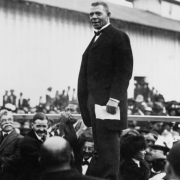In 1937, Poetic Justice Warrior Hedwig Kiesler escaped a four year marriage to man she describes as “the absolute monarch in his marriage. I was like a doll. I was like a thing, some object which had to be guarded—and imprisoned—having no mind, no life of its own.” She was 18 years old when she got married to the 33 year old. Not only did she flee her husband and his ties to Hitler’s socialists in Germany and Mussolini’s fascists in Italy, Kiesler was abandoning her native Vienna for the relative safety of London. This was the year before Hitler arrived in Austria.
The Applied Scientist
While Kiesler may have thought her mind imprisoned, it remained very active. As a young girl she had taken long walks with her father, an Austrian banker, and became enthralled with the mechanical ways of the world. As a young lady, she accompanied her husband to business conferences hosted by scientists and military technology specialists. It was during these events, aided by her gifted mathematical mind, that Kiesler first learned that radio controlled torpedoes were becoming a ruinous naval weapon, but their accuracy was unreliable. To make matters worse, the signals were easily jammed by enemy transmitters.
With the outbreak of World War II, and now living and working in America, Kiesler became passionate about contributing to the American war effort and defending her native Austria. By this time, allied torpedoes were being blown up by Nazi U-Boat Wolfpacks. With an assist from her mother Trude, (Hedwig’s father Emil had died in 1935), Kiesler came up with the idea for frequency hopping. The idea was for American torpedoes to rapidly change frequencies in order to evade Nazi identification. However, this created a significant challenge, one that required a highly inventive mind – how to synchronize the remote control transmitter with the torpedo’s guidance system. As poetic justice would have it, Kiesler attended a dinner party and shared her idea with another inventive mind. One that had experience with a crude, mechanical prototype – the player piano.
During time off from her day job, Kiesler formed a partnership with this struggling music composer, George Antheil, who had also been a government munitions inspector himself. After several months of development, they sent their idea for a synchronized electronic transmitting system to The National Inventors Council; the clearinghouse for inventions with possible national defense capabilities. Encouraged by its director, Kiesler and Antheil continued to develop their technology with the help of an electrical engineer, and in June 1941 they applied for a US Patent. Their invention was officially named “Secret Communication System.” In August 1942, Markey and Antheil (Markey was her second married name) were granted patent #US397412A for “encryption being effected by mechanical apparatus, e.g. rotating cams, switches, key tape punchers” that would be deployed using high altitude aircraft. The number of frequencies to be synchronized were eighty-eight, the number of keys on a piano.
Revenge of the Frequency Jammers
According to Antheil’s sales pitch “Our fundamental two mechanisms can be made so small that they can be fitted inside of dollar watches!” Today we know them as spread spectrum technology and smart watches. Yet predictable of government elites, his appeal to the US military brass was stymied. Not only were young female inventors and entertainers not taken seriously, the idea of strapping a piano to the back of a torpedo was taking up too much space between the bureaucrat’s ears. Instead, according to fee.org contributing editor B. K. Marcus “the U.S. Navy did three things: they rejected the idea, acquired the patent to it anyway, and kept the technology secret for almost 40 years.” He then asks,
What if the federal government hadn’t cartelized the communications industry? What if the industry itself hadn’t sought government protection from innovation? What if competition had been allowed to thrive in the tech industry of the mid-twentieth century?
Kiesler’s short-lived gig as a high-tech inventor for the American government had one fatal flaw. She trusted the American government and their command and control culture of centralized authority. Kiesler and Antheil, quite naturally at the time, had faith in their government’s fight for individual rights and free markets against the forces of socialism and fascism that were brutalizing Europe. Their patent expired unused in 1959, the year of Antheil’s death. As libertarian author Jeffrey Tucker explains, “Knowledge alone does not serve society. Knowledge put to use in a market setting—science turned into the ‘practical arts’—is what serves the human population.”
Beginning with the Carter administration in the late 1970s, and accelerating during the Reagan years, the National Security Agency declassified scores of patents, including spread spectrum technology, to the dissatisfaction of technology industry cronies. According to then FCC Chairman Michael Marcus,
Regulations prevented rapid innovation and prevented both new entrants and technological surprise from the few competitors. It was a cozy oligarchy for the major manufacturers, but it denied the public the benefits of rapid introduction of new technologies.
Kiesler’s Secret Communication System also allowed multiple signals to share the same spectrum without interference, now known as CDMA (Code Division Multiple Access) and TDMA (Time Division Multiple Access). Thanks to deregulation and the invention of the microchip, it is now fundamental to cell phones, Wi-Fi, Bluetooth, and the new sharing economy of companies like Uber, Airbnb, and thousands of new media outlets. These life-enhancing efficiencies naturally lead to immense wealth creation and its looters – new government regulation. Thanks now to California’s Assembly Bill 5, dozens of politicians and bureaucrats of the Luddite persuasion will force thousands of value-creating freelancers out of their chosen Gig Economy livelihoods. The majority of them are women, and all of them victims of the politically connected.
Wonder Woman
Just as Nikola Tesla‘s innovative, yet naïve, genius went largely unrewarded and unrecognized for years after his death, Kiesler and Antheil never earned anything from their patent, even though she learned twenty years later it was being used by the US Navy in the blockade of Cuba. However, aviation pioneer Howard Hughes had become aware of Kiesler’s inventive prowess and gave her access to his engineers. By studying the aerodynamics of the fastest birds, she made recommendations to Hughes for more efficient airframe designs.
Still, one of her biggest regrets was that her intelligence was largely unnoticed, “Any girl can be glamorous. All you have to do is stand still and look stupid.” Well, maybe not just any girl. According to Liberty magazine writer Howard Sharpe, after an interview he had with Kiesler that was published in 1938:
Hedy has incredible personal sophistication. She knows the peculiarly European art of being womanly; she knows what attracts men, and forces herself to be these things. She has magnetism with warmth, something that Dietrich nor Garbo managed to achieve.
About attractive men Kiesler says “I have never seen a wrestling match or prize fight, and I don’t want to. When I find out a man is interested in these sports, I drop him.” Historian Richard Rhodes adds, “Of all the European émigrés who escaped Nazi Germany, she was one of the few who succeeded in moving to another culture. She really was a resourceful human being, I think because of her father’s strong influence on her as a child.”
If you are reading this on a wireless device connected to the internet, think of Hedy Lamarr.













